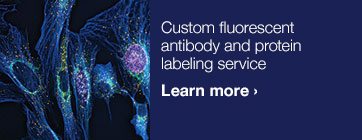Biotin Binding Protein Conjugates
- ‹ Antibodies
- Biotin Binding Protein Conjugates
- Custom Antibody Production
- Custom Antibody Purification
- OpenProject Antibody Production Web Tool
- Custom Antibody FAQs
- Custom Antibody Request
- Primary Antibodies
- Secondary Antibodies
- Custom Antibodies
- Antibody Production
- Antibody Purification
- Antibody Labeling Kits
- Immunoassays
- Antibody Performance Guarantee
- Invitrogen Antibody Validation
- Antibodies Learning Center
- eBioscience
- eLearning Courses

Streptavidin-based amplification techniques are widely used in flow cytometry, fluorescent imaging, western blotting, and microplate-based detection for increased signal output and greater sensitivity. Fluorescent conjugates of streptavidin are used to detect biotinylated biomolecules such as primary and secondary antibodies, ligands and toxins, or DNA probes for in situ hybridization or bead-based detection. Enzyme conjugates of streptavidin, such as HRP and AP, are commonly used in western blotting, ELISA, and in situ hybridization imaging applications. Streptavidin-conjugated magnetic beads and resins can be used to isolate proteins, cells, and DNA, or they can be used in immunoassays or bio-panning.
Our family of biotin-binding proteins includes streptavidin, avidin, and NeutrAvidin® protein. Each protein binds four biotins per molecule with high affinity and selectivity.
- treptavidinis most commonly used—it is non-glycosylated and exhibits low levels of nonspecific binding.
- Avidinis a highly cationic glycoprotein with an isoelectric point of about 10.5—it can cause nonspecific background staining in some applications due to its positively charged residues and oligosaccharide components.
- NeutrAvidin®protein has been processed to remove the carbohydrate and lower its isoelectric point, resulting reduced nonspecific background staining.
Popular products

Fluorescent streptavidin and avidin conjugates
We offer a wide array of high quality fluorescent conjugates of streptavidin and avidin biotin-binding proteins. Learn more about our fluorescent streptavidin and avidin conjugates:
- Alexa Fluor® streptavidin and avidin conjugates
- DyLight® streptavidin and avidin conjugates
- Streptavidin phycoerythrin (RPE), APC, and tandem conjugates for flow cytomtery, Luminex® assays, and microarrays
- View all Qdot® probe streptavidin conjugates
- View all classic fluorescent streptavidin and avidin conjugates (FITC, TRITC, Texas Red® dye)
Enzyme-labeled streptavidin and avidin conjugates
Enzyme-labeled conjugates of streptavidin and avidin biotin-binding proteins, including streptavidin horseradish peroxidase (HRP) and streptavidin alkaline phosphatase (AP), provide tools needed for ELISA, chemiluminescence detection, and western blot analysis as well as immunohistochemistry and immunocytochemistry.
View our enzyme-labeled streptavidin and avidin conjugates

Biotin and biotinylated conjugates
Biotinylation reagents provide the "tag" that transforms the poorly detectable molecules into probes that can be recognized by a labeled detection reagent or an affinity-capture matrix. Once tagged with biotin or a hapten, a molecule of interest—such as an antibody, lectin, drug, polynucleotide, polysaccharide, or receptor ligand—can be used to probe complex solutions, cells, and tissues, as well as protein and nucleic acid blots and arrays. We offer a broad range of products for labeling your molecules or biomolecules that are already labeled with biotin as well as kits to label proteins and antibodies.

Bulk Quantities and Custom Products
Partner with us to scale-up your process or product development pipeline with bulk quantities of high-quality immunoassay reagents and biochemicals. We offer a variety of compounds, devices, and resins for your large-scale applications.
Resources
For Research Use Only. Not for use in diagnostic procedures.




